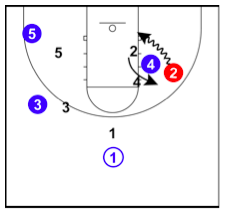Buried deep in Seth Davis’ Sports Illustrated post last week was this little gem. “I know we are in the Age of the Ball Screen, but I think coaches use this tactic too frequently. I don’t like the way a ball screen brings a second defender to the dribbler. If I’ve got a quick guard, I’d prefer to give him as much space as possible and let him take his man off the dribble.”
I couldn’t agree more. Actually, it isn’t the ball screen I have a problem with. It’s the high ball screen featuring a one or more 6’8” bigs at the top of the circle trying to free a dribbler for a long jumper or drive down the lane.
 There are several problems with it:
There are several problems with it:
• The court is congested with five defenders essentially guarding three.
• The dribbler is already committed to… dribbling… and dribbling… and dribbling deeper into the shot clock.
• The dribbler is seldom freed for the jumper and almost never makes it all the way to the rim on his drive.
• When he rolls, the screener seldom receives the return pass and when he does, is too far from the basket to be effective.
• The end result is a pitch to the deep corner for a three-point attempt that is missed nearly 70% of the time and usually rebounded by the defense.
And we wonder why scoring and shooting percentages have steadily declined since the 1971-72 season?
The high ball screen is too slow developing and occurs in a position on the court where help is readily available. As Seth Davis suggests, the more potent offensive scheme is to open the floor and get out of the dribbler’s way.
 For example, aligning four players along the end line creates lots of room for maneuver and opportunities for a short pull-up jumper if the layup is prevented. If you add scraping or flex action to the baseline players you isolate the driver even further and make help defense a risky proposition.
For example, aligning four players along the end line creates lots of room for maneuver and opportunities for a short pull-up jumper if the layup is prevented. If you add scraping or flex action to the baseline players you isolate the driver even further and make help defense a risky proposition.
If you’re still insistent on maximizing the three-point option, then adjust the attacking formation accordingly. In the diagram below, the driver has plenty of room to maneuver; #5 is in the “drop zone” close to the basket to penalize the help defender; the corner attacker is in position for a three-point attempt or a slip to the basket if his defender rotates to the driver.
Both these schemes are elegantly simple and quick-hitting.
Question: And what about the ball screen? Where and when is it effective?
Answer: At the wing, 12-15 feet from the basket in the hands of an attacker facing the basket prepared to shoot with his dribble live.
In other words, he is an immediate offensive threat with room to maneuver left or right. He can shoot, put the ball on the floor to attack the rim or to take a short pull-up jumper. The ball’s close proximity to the basket dramatically cuts the defenders’ reaction time, creating simple reads for both the ball handler and his screening partner. It’s quick-hitting, two-on-two basketball at its finest.





Don’t see many mid-range jumpers taken these days. So after screening it would seem the tendency is to drive, kick out for a three or give up and try a different play rather than taking the 12-15 footer.
You’re right on target. I will respond more fully in a future posting but for now, here’s a quick response. The unintended consequences of the three-point shot are three-fold: (a) it’s created an “either/or” situation in which players look for two kind of shots — the spectacular dunk or the dramatic three — both of which may get you on ESPN; (b) it’s re-defined the mid-range jump shot to include all two-point attempts except those at the rim. In other words, a 12’ baby jumper or an 8’ bank shot (ever see those anymore?) is weighted “the same” as a long two-point attempt just inside the three-point line. In reality, we ought to be measuring shooting percentage in four classes of shots – at the rim, the short two-point attempts, long two-point attempts, and the three-pointers; (c) shooting percentages and scoring have declined.
Cousin Mark,
Your blog is both educational and entertaining…Great stuff. Looking forward to absorbing more of it. Cheers,
Tim
Thanks!!
I am still with the two hand set shot. Also the pick and roll.
Cool analysis……like going to the old clinics
Like the photo, Mark, Hoosiers, a great flim….
Coach, great “to hear your voice.” Thanks for your kind comments. Hope you will share your insights and years of court side experience in the months ahead.
Pingback: Revisiting the High Ball Screen | better than a layup